

Swenson Timeline MajorWWII Events handout. "Harry's Story" - Memories of Hiding Jews and Nazi Brutality during WWII. Netherlands during (tijdens) WW2 1940-45. Second World War. Second World War. World War II in popular culture. There is a wide range of ways in which people have represented World War II in popular culture.
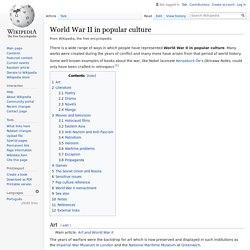
World War II Printable Worksheets and Coloring Pages. What Japanese history lessons leave out. Japanese people often fail to understand why neighbouring countries harbour a grudge over events that happened in the 1930s and 40s.
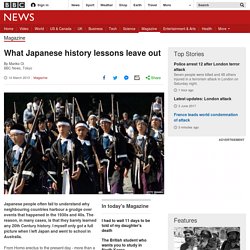
The reason, in many cases, is that they barely learned any 20th Century history. I myself only got a full picture when I left Japan and went to school in Australia. From Homo erectus to the present day - more than a million years of history in just one year of lessons. War music: the humanity, heroism and propaganda behind Shostakovich’s Symphony No 7. When Shostakovich played the first two movements of his Seventh Symphony to his friends in the besieged city of Leningrad in the summer of 1941, his performance was interrupted by a German bombardment.
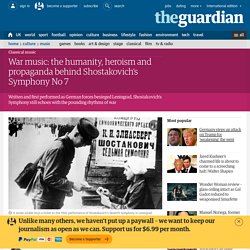
As the air-raid sirens began to blare after he had finished playing the gigantic first movement – music that dramatises, parodies and immortalises the German invasion – he assured his audience that he would return to play the second just as soon as the warning had stopped and he had taken his wife and children to the shelter. As one of his listeners that day, the critic and composer Valerian Bogdanov-Berezovsky, later wrote, the Seventh Symphony “is an extraordinary example of a synchronised, instant creative reaction to events as they are being lived through, transmitted in a complex, large-scale form, yet without the slightest hint of compromising the standard of the genre”.
People's Century Part 10 1939 Total War. BBC Schools - Life in the trenches. 31 October 2014Last updated at 15:07 Two British soldiers standing in a flooded communication trench during World War One On the Western Front, the war was fought in trenches. Trenches were long, narrow ditches dug into the ground where soldiers lived all day and night. There were many lines of German trenches on one side and many lines of Allied trenches on the other.
In the middle, was no man's land, so-called because it did not belong to either army. Rest. Life in the Trenches. Life in the trenches during the First World War took many forms, and varied widely from sector to sector and from front to front.
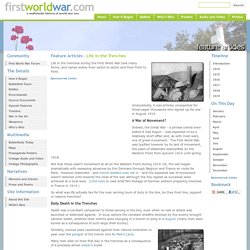
Undoubtedly, it was entirely unexpected for those eager thousands who signed up for war in August 1914. A War of Movement? Indeed, the Great War - a phrase coined even before it had begun - was expected to be a relatively short affair and, as with most wars, one of great movement. The First World War was typified however by its lack of movement, the years of stalemate exemplified on the Western Front from autumn 1914 until spring 1918.
Not that there wasn't movement at all on the Western Front during 1914-18; the war began dramatically with sweeping advances by the Germans through Belgium and France en route for Paris. People's Century. Text versionAbout the Series | Episodes | Timeline | Your Stories | Thematic Overview | Teacher's Guide People's Century | WGBH | PBS Online | Search PBS | Feedback | Shop | ©

People's Century. The following lesson focuses on a program segment about the evacuation of children from war zones, the drafting of British women to produce military equipment, and the bombings of London and Plymouth.
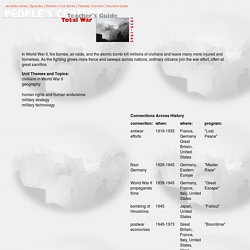
European citizens recall their experiences. Discussion Before Watching 1. As a class, brainstorm definitions of the term total war. Discuss examples of total war and who is affected by it. As students watch the program segment, have them consider if and how they might change their definitions. 2. The Impact of Total War - Dictionary definition of The Impact of Total War. World War II Reference Library COPYRIGHT 2000 The Gale Group Inc.
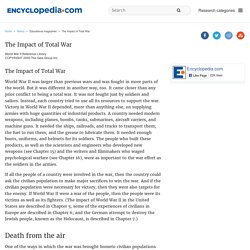
World War II was larger than previous wars and was fought in more parts of the world. But it was different in another way, too. It came closer than any prior conflict to being a total war. It was not fought just by soldiers and sailors. Instead, each country tried to use all its resources to support the war. Homepage - anne frank. 80 years later, the Nazi war crime at Guernica still matters. Want smart analysis of the most important news in your inbox every weekday along with other global reads, interesting ideas and opinions to know?

Sign up for the Today's WorldView newsletter. The Nazi aircraft appeared above Guernica in the late afternoon of April 26, 1937. It was market day in the historic Basque town, with hundreds of residents congregated in the central square. They couldn't have imagined what was about to happen: Over the next three hours, the planes dropped 100,000 pounds of high-explosive and incendiary bombs, reducing Guernica to a smoldering ruin. Britain's Home Front in WW1. The most haunting account of the trenches you'll ever read - from a brilliant anthology by Birdsong author Sebastian Faulks
They are the forgotten voices of World War I, brought to life in a heart-rending new anthology.

On Saturday, we heard from a war poet’s wife on their last hours together before he went off to die. Art and Trauma: Creativity As a Resiliency Factor. A perception of artists as eccentric, different, and living on the social periphery seems to precede this group outside of therapy and, likely, within the context of treatment as well.

There seems to be an unspoken premise that ingenuity is motivated by pain or pathology, or at least some might argue there is a sort of affiliation. Some might assume that this relationship is causal: that trauma causes creativity and thus most artists are contending with some type of affliction. An alternative possibility may be that art is not necessarily motivated by pain; rather the capacity for creative inspiration is something that is brought into the recovery process by those who have such inclinations. In other words, some survivors who are able to express through art may have access to a recovery tool that others do not. Extracts from the diary of Anne Frank (1942-44) The following extracts are taken from the diary of Anne Frank between 1942 and 1944, when she lived in hiding in Amsterdam with her family.
The Franks were discovered, arrested and transported to Auschwitz on August 4th 1944. July 8th 1942: “At three o’clock (Hello had left but was supposed to come back later), the doorbell rang. I didn’t hear it, since I was out on the balcony, lazily reading in the sun. War artists. Introduction In Britain official government-sponsored schemes were established for artists to record both the First and Second World Wars. Second World War: Art. Art forever changed by World War I. A scene from “All Quiet on the Western Front” from 1930. (Universal Pictures, Universal…) Along with millions of idealistic young men who were cut to pieces by machine guns and obliterated by artillery shells, there was another major casualty of World War I: traditional ideas about Western art. The Art of World War One in 52 Paintings. Since the First World War was fought at a time of major changes in artistic movements, the period is particularly rich with a variety of art styles. The development of photography in the late 19th Century had pushed painting particularly away from realism, into a broad group called expressionism.
The movement sought to present the world subjectively, radically distorting it for emotional effect – famous artists such as Edvard Munch, Paul Klee and Wassilly Kandinsky were all expressionists. The effect of the movement meeting the cataclysm of the war saw expressionist painting directly related to the fighting appear across Europe. In Britain, some of the more prominent works related to the war abandoned realistic styles and combined with the trend of Italian Futurism and Cubism to create Vorticism.
Industrial warfare, shattered landscapes and the horrors of the battlefield suited modernist styles, and art often escaped earlier realism. First World War Art. War Art - Online Exhibition, National WWI Museum. History - The Home Front (pictures, video, facts & news) Total War and Effects. Total war is the practice of war where nearly all the resources of a society are employed to defeat an opponent. This also means that any resources used by the enemy are also legitimate targets of war. As a result, factories, pipelines, railroads, bridges, etc. become legitimate targets in war.
This does not mean that all is permitted, however. Total war. History - World Wars: The Western Front and the Birth of Total War. Wilfred Owen - Poet. On March 18, 1893, Wilfred Edward Salter Owen was born in Shropshire, England. The War Poet Association. The Great War . Educational Resources . Lesson Plan 3. Download/Print this Lesson (pdf) | Adobe Reader required. Death poem. The jisei, or death poem, of Kuroki Hiroshi, a Japanese sailor who died in a Kaiten suicide torpedo accident on 7 September 1944.